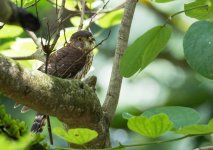Hi all,
meant H. varius as a definite possibility for some of the photographs not the smaller, Indian Cuckoo micropterus. If the bigger birds have a tail as a big as a hawk then agree sparverioides is the only solution to these. A lot of the northern migratory sparverioides do not have dark, ferruginous upper breasts like in these birds.
With regard to Andy's request about #18. Would suggest look to the oriental, saturatus groupings for this bird not the micropterus, Indian Cuckoo. If it was seen at a higher elevation then Sunda is a possibility. I have a detailed description description of my own of this species. Presumably the immature bird is a Sunda Cuckoo, not Indian or Oriental, if from a really high elevation.
The problem with identifying the Indian Cuckoo, micropterus, is that from the front it looks like a conventional grey cuckoo, whereas both sexes from behind look brown grey, like a cuckoo hawk.
Regret mentioning Hodgson's because lighter tertials are a feature of several species, but Hodgson's it is a likely candidate for Singapore being tolerant of mixed coastal scrub and forest. Those pink buff patches on the upper tertials are a good field mark on an otherwise impenetrable overall brown, vermiculated immature.






